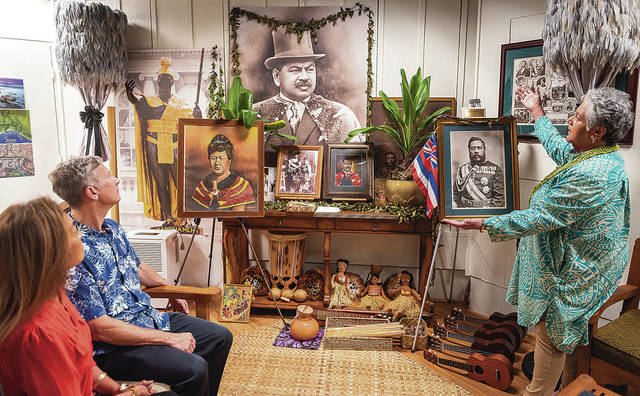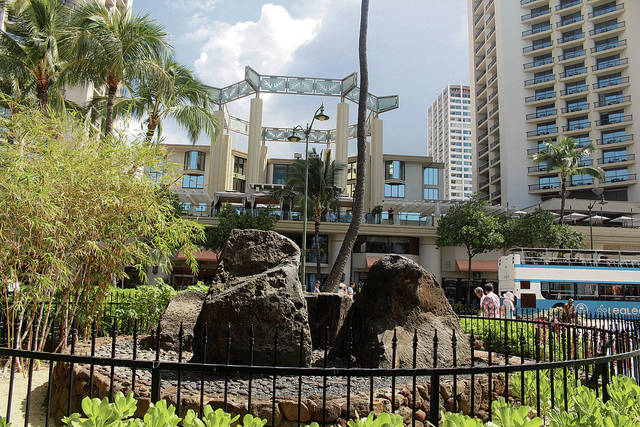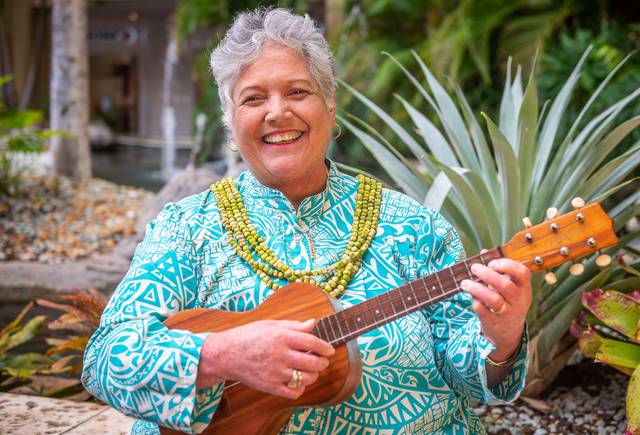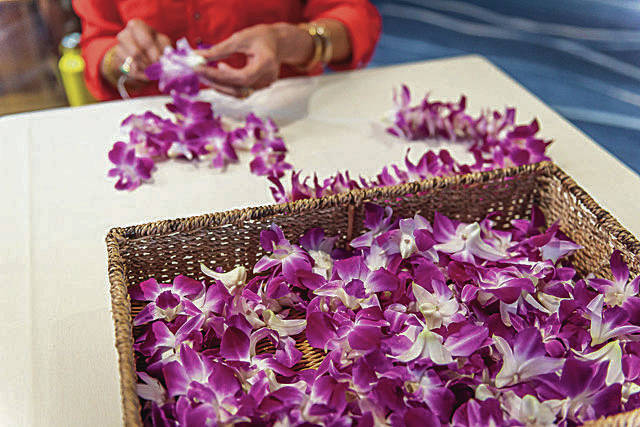The significance of songwriter and recording artist Ku‘uipo Kumukahi’s Waikiki tour begins with its name: E Ho‘ala E, which means “revive, renew, restore.”
“ ‘Revive’ refers to knowledge and traditions that Hawaiians are working to bring to the forefront. ‘Renew’ suggests the ties to our ancestors that are strengthened when we do that. ‘Restore’ is the ultimate goal: ensuring that the Hawaiian culture has a lasting and influential place in society today,” said Kumukahi, Hyatt Regency Waikiki Beach Resort & Spa’s manager of Hawaiian culture and community relations.
Kumukahi says the weekly tour serves as a valuable educational tool. And, she stresses, it’s not just for visitors.
“Kamaaina take the tour with friends and relatives from elsewhere and say they learned just as much as their guests did,” she said. “It winds up being a time of discovery for everyone.”
E Ho‘ala E begins and ends at the hotel’s Ho‘okela Hawaiian Heritage and Culture Center, which Kumukahi has furnished with books, musical instruments, Hawaiian flags, wooden calabashes, kahili (feather standards) and historical photos.
IF YOU GO: E HOʻALA E
>> Meeting place: Ho‘okela Hawaiian Heritage and Culture Center, second floor of the Diamond Head Tower, Hyatt Regency Waikiki Beach Resort & Spa, 2424 Kalakaua Ave.
>> When: 10 to 11:30 a.m. Tuesdays
>> Cost: Free
>> Phone: 237-6196
>> Email: kuuipo.kumukahi@hyatt.com
>> On the Net: HyattRegencyWaikiki.com
>> Notes: The Ho‘okela Hawaiian Heritage and Culture Center is open 8:30 a.m. to 5 p.m. weekdays. Free hula, lei making and ukulele classes are available from 10:30 a.m. to 2:30 p.m. Mondays through Thursdays and noon to 4 p.m. Fridays. Private classes for groups of 10 or more are $10 per person.
A large, lei-draped portrait of Prince Jonah Kuhio Kalaniana‘ole, looking dapper in a suit and top hat, dominates one wall. He and his wife, Princess Elizabeth Kahanu Ka‘auwai, were the last royal residents of Pualeilani (“heavenly flower lei”), where the Hyatt Regency Waikiki now stands. The prince gave the land that name, which refers to the abundance of beautiful, fragrant blossoms that flourished at his seaside home there.
Had the Hawaiian monarchy not been overthrown in 1893, Prince Kuhio could have one day been king. Instead, he served his people from 1903 until his death in 1922 as the only delegate to the U.S. Congress of royal descent. His many accomplishments included founding the first Hawaiian civic club in 1918 (there are now 58 such organizations across the country) and sponsoring the 1920 Hawaiian Homes Commission Act, which grants qualifying Hawaiians 99-year land leases for residential, agricultural or ranching purposes for $1 per year.
“During the tour, I make it a point to honor Prince Kuhio and other alii for their concern about the welfare of Hawaiians and their diligence as leaders,” Kumukahi said. “Hawaiians today must uphold their legacy by ensuring our language and traditions are perpetuated. Hawaii is not about grass skirts, mai tais and coconut bras. We have to be sure our authentic stories are told.”
Stops include the Healing Stones on Kuhio Beach. According to Kumukahi, four Tahitian healers came to Hawaii about 400 A.D. to teach the people about the emotional, mental, physical and spiritual aspects of healing. Before they returned to Tahiti, the Hawaiians memorialized them with huge stones, each weighing more than 2-½ tons.
COMING UP
>> The Hyatt Regency Waikiki will host a free program, Waikiki by Moonlight, 7 to 8 p.m. Dec. 23 in the Pualeilani Atrium on the ground floor. It will honor the late Palani Vaughan, who was inducted into the Hawaiian Music and Dance Hall of Fame in 2008. His daughter Hiwa Vaughan will be among the performers.
>> Aloha Waikiki, featuring Ku‘uipo Kumukahi and the Pualeilani Shops Serenaders, is held from 5:30 to 7 p.m. Wednesdays in the Pualeilani Atrium. Parking is free for four hours with validation from SHOR, the SWIM bar or the Buffet at Hyatt.
For many years, unknowing beachgoers sat on the stones and draped towels on them. A fence protecting them was erected in 1997, and therapists from the Hyatt Regency Waikiki’s Na Ho‘ola Spa have assumed the responsibility of keeping the site clean.
“They can’t go inside, but as they’re picking up litter and leaves outside the fence, they feel the power of the stones,” Kumukahi said. “They’re able to transfer that healing energy to their clients.”
Another highlight is the Hawaiian Music and Dance Hall of Fame historical exhibit, which has a permanent home at the hotel. The founding board of the nonprofit Hawaiian Music Hall of Fame (hmhof.org), established in 1994, conceived the idea for the exhibit, which comprises five large displays framed in koa that feature images and information about the history of Hawaiian music and 32 notable singers, musicians, chanters and composers who were the first inductees. They include Na Lani ‘Eha (the Royal Four) — siblings King Kalakaua, Queen Lili‘uokalani, Prince William Pitt Leleiohoku and Princess Miriam Likelike — who were all accomplished musicians and composers of songs, chants and poetry.
“We regard them as the patrons of what is now known as the Hawaiian Music and Dance Hall of Fame,” Kumukahi said. “When I and other artists recorded the album Na Lani ‘Eha in 2007 for the organization, we realized we could not name any other sovereign during their time, the mid-to-late 1800s, who wrote poetry and put it to music. That set them apart from other world leaders, and the talent they shared as beloved alii no doubt inspired Hawaiians and encouraged the growth of musical arts in Hawaii.
“Since 1995, there have been 124 inductees to the Hawaiian Music and Dance Hall of Fame, among them bands, hula masters, church choirs, nine songs and two songbooks.”
Kumukahi always concludes E Ho‘ala E with a song, then invites participants to pick up ukuleles and “kani ka pila kakou” (make music together).
“When they view the Hawaiian Music and Dance Hall of Fame exhibit, they see how important music was and is to Hawaiians,” she said. “It connects us to our history, our ancestors and our islands, and unites us as a people. Groups who do the tour also experience that magic. They come as strangers, but, through music, they leave with a sense of ohana.”
Cheryl Chee Tsutsumi is a Honolulu-based freelance writer whose travel features for the Star-Advertiser have won several Society of American Travel Writers awards.








